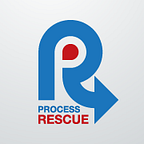Process ‘Mavericks’ and how to avoid monitoring compliance
I’ve worked in many organisations that have very low compliance with the documented process. Staff are often happy enough to be Process ‘Mavericks’, gunslinging their way through one process crisis after another. After a period doing this the culture of being a quick shooter, rolling into the next saloon and blasting away problems (well so it seems at first glance), and can become addictive for some people.
OK, I exaggerate a little, but sometimes you do begin to wonder!
Any attempt to hold to account by comparing documented activities to actual practice is rounded on with a ‘we don’t do that anymore’, or ‘that’s way out of date’, leaving process operators free to do what makes a difference in their eyes, regardless of the downstream consequences.
This is my first alarm bell when working with a new customer, and it happens more often than not. It tells me two things
- No one is responsible for keeping the documentation up to date!
- It just isn’t used, so of course it's out of date. If it was used, then someone would point out the errors and get them fixed.
- Shockingly, when someone new starts they are pointed at the out-of-date documentation and told to learn it, baking in the confusion!
But like gunslingers, Process Mavericks go on to the next crisis ignoring the freshly minted mess which someone has to clean up behind them by a fast-growing customer service group, account managers or similar.
The few managers that get clear of the mayhem to attempt to address the causes will often quite reasonably demand some sort of process compliance to ensure consistency of delivery. That’s a laudable ambition, after all, if everyone is doing it the same way we can at least track down the problems to fix right?
But, what usually happens is the focus shifts to determining whose work is outside some arbitrary tolerance range based on silo-focussed metrics. This is perceived very negatively by staff and triggers arguments about what is the right process anyway, what are the exceptions, are the targets reasonable etc.
This is a waste of your time and given that time is money, you’re also wasting dollars. Not to mention the mental health of yourself and your staff! It’s inevitable that your customer gets to feel the pain or soon will do.
This is no way to live! To those that are doing this, I have this message… STOP!
You are already managing performance. It’s just that poor performance has already happened. What if I told you it doesn’t have to be this way?
A far more effective approach is to -
1. Establish a cross-functional team. aligned to the delivery of the product or service. Note: they still report to their existing line manager.
2. Foster collaboration. One method to help achieve this is to set targets for the whole team, centering any incentive, celebration, reward etc at the team level.
3. Develop a process that puts the customer at the centre (obviously) and satisfies the needs of each business unit to do their role the best they can.
4. Get rid of measures that are aligned to the performance of an individual business unit! It’s crucial that you free yourselves of as much of this as you can as it really undermines collaboration.
It makes sense that your measure is based on the outcome for the customer, as you’ve made them a promise in your marketing campaigns. They are expecting your service to be within the spec that you promised at the time! Delivering something different will ensure that you avoid their repeat business!
The team needs to have a degree of autonomy to make decisions to improve the process but must be armed with good practice to tradeoff the ideal solution and pragmatism! A good approach is to aim to achieve the ideal solution at the outset and be prepared to compromise where you have to.
For the process to have sufficient priority there must be accountability. The simplest way to achieve that is to appoint a process owner. The owner is responsible for the performance of the process. They are not an escalation point or the complaints department! Otherwise, they get sucked back into the vortex of day-to-day crisis management. This is a role that should be focussed on proactive management. Or to push the analogy further, cut crises off at the pass!
Typically, the process owner is one of the resource managers across the functions, but it doesn’t have to be. Whoever it is, they will not have authority over staff across the whole process so must establish effective relationships with managers of the other resources.
Once a cross-functional process team is formed it makes sense to help staff think in a process-centric way to increase the effectiveness of process improvements. This could be achieved to some degree by holding a mass training event, but I wouldn’t recommend this as your first priority. As the bang for your buck on this approach isn’t great.
A better way is to provide opportunities for hands-on experience in the process teams, along with smaller more focussed training to support the task at hand. This can be supported by a small group of process specialists.
All of this speaks to developing a process culture that is enduring, supportive, inclusive, and empowering!
